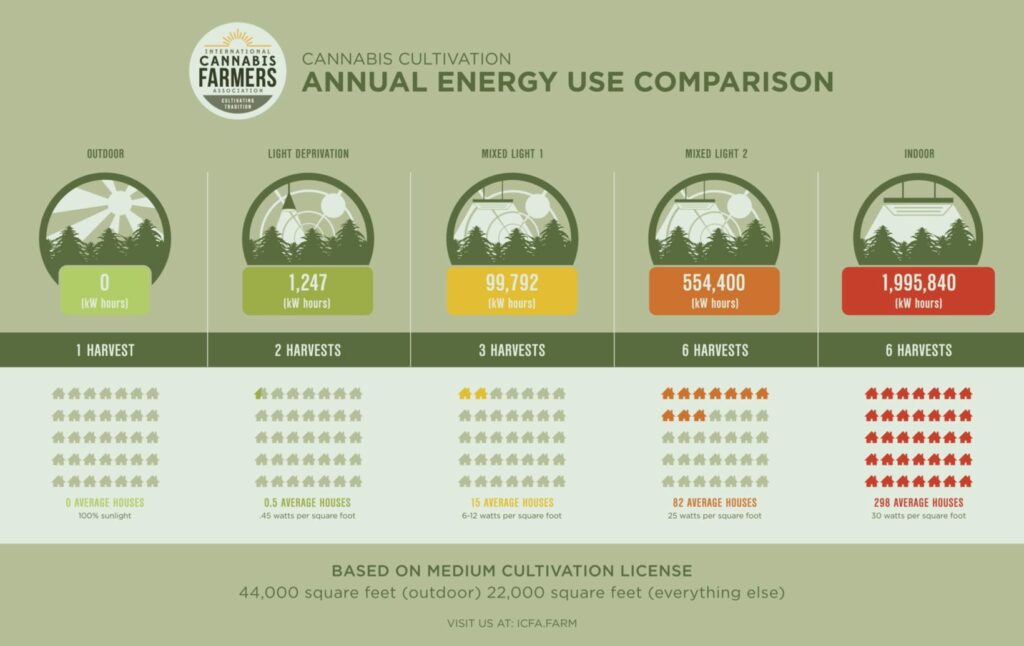The huge underground cannabis economy was woven into the commercial fabric of California long before the 2016 passage of Proposition 64, which legalized marijuana for adult use. Transforming a shadowy, multibillion-dollar industry into a heavily taxed and regulated structure presents unique and enormous challenges. Who will gain and who will lose under the new regime? Will the expected financial dividend from legalization be broadly distributed throughout the Golden State?
California’s cannabis regulations are supposed to accomplish two key objectives: Curtail illicit sales and rein in extensive harm to the natural environment caused by black market growers. But the way legalization is being implemented could have the opposite effect. Steep taxes, higher operating costs, and an insatiable out-of-state demand for California cannabis all but ensure that the black market will survive – if not thrive – in the near term and ecological abuse will continue, as Angela Bacca reports in this special, three-part series.
Eco-Crisis: Will Cannabis Legalization Save California’s Forests?
California’s North Coast, unlike the densely populated semi-arid deserts of the south, is both wet and green. Its lush rainforests contain some of the world’s oldest and tallest trees and are home to rare and unique species. But folks who live in this area have struggled to survive in a hardscrabble, boom and bust economy characterized by commodity extraction and production. Logging trees became the region’s first big business, and today what is left of them are Northern California’s biggest tourist attraction.
In the tiny community of Leggett, tourists drive through a seven-foot wide hole cut into the bottom of a nearly 300-foot redwood tree. Sometimes the visitors bypass the main road, Highway 101, to admire the towering trees as they drive along The Avenue of the Giants, which winds through an ancient, majestic redwood forest.
In the autumn, anyone driving up Highway 101 can also catch a whiff of the region’s most famous export – marijuana.
Cannabis cultivation has never been a well-kept secret in the Emerald Triangle, America’s marijuana breadbasket, which includes Mendocino, Humboldt and Trinity Counties. For hundreds of miles – from San Francisco to the Oregon border – billboards advertise events like the yearly Emerald Cup, a Northern California harvest festival that showcases the best of the region’s growers and artisanal product-makers.
The few small towns that line the highway typically only have one main street, but many prominently placed cannabis-themed businesses. During harvest season, trimming shears go on sale at grocery store checkouts. Every year, young marijuana migrants (aka “trimmigrants”) come from far and wide and are seen hitch-hiking up Highway 101 looking for work, hoping to process the harvest.
The first wave of marijuana farmers who settled in the region in the late 1960s and early 1970s identified with the back-to-the-land movement. Imbued with countercultural idealism, many of the original growers were environmentalists who eschewed the extractive capitalist practices that over-logged and overfished the Pacific forests and North Coast.
Some homesteaders found that growing a modest cannabis crop afforded the means to fight for wilderness protection and engage in other forms of ecological activism. “Farming with attitude,” as one Emerald Triangle resident described under-the-radar cannabis cultivation, spawned small, sustainable, community-oriented businesses that continue to endow the region with its unique character.
Death by a Thousand Cuts
But today’s cultivation scene is more complicated and less altruistic. The green ethos that prevailed in the early days has given way to a different set of players, including Wall Street-backed corporations with deep pockets and black market growers who exploit state laws and pollute the dense forests that provide cover for their illicit operations. These Green Rush interlopers are causing irreversible damage to the state’s water supply and precious natural resources.
“Think of this as death by a thousand cuts,” said Stormer Feiler, a senior environmental scientist with the North Coast Regional Water Quality Control Board.
Feiler, who works in the Water Board’s cannabis regulatory program as an enforcement specialist, is referring to the plots of private and public forest lands that are “cut” into marijuana grow sites. “Cuts” are made by chopping down old growth trees and diverting water out of local streams. Often the growers that occupy the cuts spread dangerous fertilizers and pesticides, poisoning the habitats of the region’s endangered species.
Many of the cuts are carved into steep mountain slopes, causing erosion and mudslides that can choke off streams. Each cut into the forest has its own impact, but the sheer magnitude of cuts made in the last 20 years – since medical marijuana became legal in California – is overwhelming state officials.
Feiler has lived in Mendocino County for 40 years. He worked as a millworker when the region’s main product was timber. Feiler saw firsthand the damage caused by overfishing and over-logging the region, which led to the decline of both industries and high unemployment. The end of timber clear-cutting in the 1990s happened to coincide with the advent of legal medical cannabis in California.
“The timber infrastructure had collapsed, and those jobs were disappearing. There were a lot of displaced workers who turned to marijuana cultivation,” Feiler recounted. “Cannabis farming was a viable economic alternative if you were willing to take the risk.”
Boom & Bust
The North Coast economy has always been characterized by “boom and bust” industries that capitalized on the region’s finite natural resources. The discovery of gold in the Sierra Nevada mountains in 1848 triggered a stampede of 300,000 people to California and a fast-track to American statehood in 1850. But tales of California’s newly minted Gold Rush millionaires obscured the fact that most prospectors who panned the streams and worked the mines didn’t make it rich.
What’s more, the long-term cost of the Gold Rush would be felt long after the mineral wealth was extracted. Today, the Golden State is still footing the bill to clean up an estimated 20,000 toxic abandoned gold mines littered throughout California’s landscape.
Humboldt County environmental scientist Dr. Mourad Gabriel says the region should learn from the mistakes made during the 19th century Gold Rush. He warns that future generations will end up paying dearly to clean up the ecological damage already inflicted by legions of marijuana growers who are operating by stealth in the North Coast’s forests.
Once rushing rivers and the streams that fed them are running dry as more marijuana growers divert water to irrigate their cash crop. The fish that live in these waterways become trapped in stagnant pools where they starve, fail to spawn and die. Most egregiously, dangerous pesticides and rodenticides are deployed around grow sites to keep mammalian predators from chewing on cannabis roots and stalks.
These pesticides not only end up in cannabis consumed by humans – they are also poisoning the food chain and destroying rare habitats. Pesticides have caused the decline of the Northern Spotted Owl and the mass die-off of the Pacific Fisher, an endangered weasel species. Gabriel refers to the Fisher as the “canary in the cannabis field” that rang alarm bells among scientists and led to discovery of the massive scope of the problem.
In 2004, Gabriel and wife Dr. Greta Wengert co-founded the Humboldt-based Integral Ecology Resource Center (IERC), a non-profit “dedicated to the research and conservation of wildlife and their ecosystems.” Five years later they turned their attention to the plummeting Pacific Fisher population. Their research determined that the mysterious die-off was due to internal hemorrhaging from widespread pesticide exposure.
More recently they found carbofuran, a highly toxic pesticide, at cannabis grow sites. Small doses of carbofuran can kill large animals and humans. Gabriel warns that these chemicals could end up in crucial waterways that supply the state’s major cities. “What amount of carbofuran in the water supply is acceptable in San Francisco?” he asks.
Gabriel’s efforts to educate the public about damage to North Coast ecosystems caused by the Green Rush infuriated some growers. In 2014, one of his family dogs was found dead from poisoning in his yard.
Satellite Imagery
Undaunted, Gabriel maintains it is imperative for future generations that science prevail in assessing the impacts of all the “cuts” on the land so that adequate remediation efforts can be pursued. The problem, he cautions, is already much larger and costlier than most people realize. Site-by-site cleanup is expensive – and beyond the resources of the various non-governmental organizations, law enforcement, researchers, scientists and state agencies that are tasked with the job.
“We are talking about possibly up to 100,000 or half a million parcels or more in California,” Gabriel said. “What we stand to lose is these natural resources [everyone is] dependent on.”
Gabriel’s estimates are based on aerial imagery. He refers to a 2017 Humboldt County Cannabis Environmental Impact Report. Using satellite imagery to identify the cuts made to private and public lands for marijuana cultivation, the county estimates that there are around 15,000 cultivation sites in Humboldt alone, a jurisdiction with just 135,000 residents.
Of these grow sites, about 2,300 have taken steps to come into compliance with the new regulations. That leaves about 85 percent of Humboldt’s cannabis farmers who are choosing not to operate in accordance with state regulations or county ordinance. Growers who did not meet the December 31 deadline will not be able to secure a license in Humboldt County until at least 2020.
Gabriel emphasizes that his concerns are not rooted in any sort of “Reefer Madness.” He has been invited to visit several small sustainable private grows and, as a Humboldt resident, he knows many in his community rely on cultivation to make ends meet.
“I look at it this way – just like logging, or any other industry that is going to [alter] these pristine and continuous landscapes, there needs to be a specific cap. There needs to be something that is going to put a regulated oversight on what occurs,” Gabriel asserted. “The long-term path to a solution is to get people enrolled and in compliance with the program’s requirements.”
Water Woes
Water is one of the most pressing issues in the Golden State. In recent years, drought-stricken California has struggled to provide water for a growing number of citizens and thirsty industries. There is always a huge demand for water in the Central Valley, where large agribusiness operations produce most of the nation’s fruit, nut and vegetable crops.
California’s current water woes are exacerbated by the marijuana-driven Green Rush. Water diversion to irrigate cannabis grow-ops on both private and public lands is a major concern of the California Water Boards and the Department of Fish and Wildlife. These agencies have collaborated on developing a pilot program for water management and oversight of legal cannabis farms in response to emergency conditions caused by a ten-year drought, extensive water diversion, and reckless pollution by pesticides and other poisons.1
The Department of Fish and Wildlife (DFW), unlike the regional Water Boards, has a law enforcement division. This division created a Marijuana Enforcement Team that works with other local and state agencies to root out trespass growers who are damaging the national forests and threatening water resources.
In 2015, Gov. Jerry Brown signed legislation expanding the Marijuana Enforcement Team’s power to levy fines on violators of the state Fish and Game Code 12025 involving “controlled substance cultivation” on private property.
Cannabis growers can incur hefty fines because of DFW infractions.
Representatives of the DFW and the state’s regional Water Boards assert their goal is not to shut down businesses that communities rely on, but to protect the state’s natural resources from the negative environmental impact of unregulated cannabis grow-ops. Although these agencies are stretched thin, they are working with farmers to bring them into compliance with state agricultural law pertaining to water and land use.
For example, the North Coast Regional Water Board launched a pilot program in 2015 to regulate water usage by legal cannabis cultivators who are compliant with state and local ordinances. The program is widely viewed as a success in Humboldt and Mendocino Counties, where it was first implemented.
In Nevada County, however, cannabis farmers who enrolled in the Water Board program or who sought county permits have been subject to enforcement action visits from the Nevada County sheriff. The punitive targeting of several growers who tried to bring their businesses into compliance sent a discouraging message to those who were unsure about emerging from the shadows of the black market.
A Sticky Situation
Local officials in the Emerald Triangle recognize that the region’s economy depends on cannabis and they understand the importance of enrolling farmers in a legal, regulated system. The hope is that legalization will help rein in ecological damage from black market grow-ops in Northern California and other parts of the state.
But the new regulations could have the opposite effect if large numbers of growers decide the legal route is still too risky and not worth the expense and hassle.
Kristin Nevedal, a Humboldt-based community activist, fears that the deck is stacked against multigenerational family farmers who practice integrated pest management, companion planting, and other sustainable, outdoor cultivation methods, which actually contribute to ecological restoration.
“Humboldt County is renowned internationally,” says Nevedal. “We were known for redwood trees – well we cut most of those down. We still have them, sure, but as an industry that’s done. Fishing was boom and bust, as well. The mainstay here, for generations, has been cannabis.”
But the legalization of marijuana is threatening to upend the Emerald Triangle’s idiosyncratic economy. “We are in a sticky situation moving into a commoditized marketplace,” says Nevedal. “It’s not about quality, it’s about price.”
She wonders whether sustainable farmers and artisanal product-makers throughout the region will be able to maintain their unique identity with corporate money looming ever larger in California’s immense cannabis industry.
These concerns prompted Nevedal and several colleagues to establish the International Cannabis Farmers Association (ICFA), a non-profit “group of farmers, scientists and stakeholders working together to promote the unique quality and ecological superiority of sun grown Cannabis products while preserving the heritage of traditional farming communities.”
Nevedal, the ICFA board chairwoman, is also co-founder of the Emerald Growers Association, a former director of the Patient Focused Certification Program at Americans for Safe Access, and a current board member of the California Cannabis Industry Association. She is particularly concerned about the economic impact of legalization on the North Coast, as well as the environmental effects of how the state is regulating cannabis.
The Sunlight Tax
A major problem, according to Nevedal, is that the current tax structure incentivizes large-scale, indoor cultivation, which is far from “green.”
This became evident when the ICFA collected and evaluated data about the profit incentive and potential environmental impacts of different types of indoor and outdoor grow licenses issued by the state. They started by researching the energy draw of different types of medium-sized (Type 3 license) cannabis gardens and they linked this information to the amount that can be harvested and price-per-pound – both of which are determined by lighting source.
Under the new tax-and-regulate rules, small farmers using the sun as a lighting source stand to lose the most.

The IFCA estimates (see chart above) that an indoor garden, unconstrained by changing seasons, can produce six harvests or more a year, but will expend 1,995,840 kilowatt hours of energy, which is the equivalent of adding 298 houses to the electrical grid. A “mixed-light” garden in a greenhouse or another structure that utilizes the sun, supplemental lighting and light deprivation techniques, expends 554,400 kilowatt hours of energy, or about the same as adding 82 houses a year to the grid.
Compared to energy-intensive indoor grow facilities, sun-grown cannabis has a low carbon footprint. An outdoor cannabis garden can produce two harvests a year at most (depending on climate and latitude) with minimal energy expenditure.
Here’s the catch: Under the new regulations, taxes do not adjust for cultivation type – but wholesale prices do.
The IFCA used recent market prices to estimate the cost of a sun-grown pound at $800, mixed-light at $1,000, and indoor at $1,400. Factoring in the high state and local cultivation taxes (for Humboldt County), farmers with the smallest license levels who grow outdoors – despite being more sustainable – will pay about 21 percent of their gross receipts in taxes, compared to a rate of about 17 percent for indoor larger scale growers. And that’s in addition to being taxed by weight at the same rate as an indoor grower.
As it stands, the state’s regulatory scheme could push small sustainable farmers out of the market entirely.
See other articles in the Green Rush Blues series.
Angela Bacca is an Oregon-based freelance journalist with an MBA and 10 years of experience in cannabis media. She specializes in coverage of cannabis in conservative states, science, medicine, politics, business, culture, and media. © Copyright, Project CBD. May not be reprinted without permission.
Endnote
According to an internal strategizing document for 2014, prepared as a collaboration between the California Water Boards and California Department of Fish and Wildlife, the agency was approached by Bill Connelly of the Butte County Board of Supervisors in 2013. Connelly was concerned about the increasing emergency conditions being caused by the drought and, more specifically, water diversion and pollution from cannabis farms.







